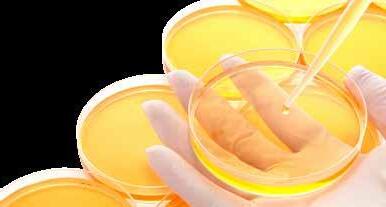
5 minute read
INFECTIOUS DISEASE
STRENGTH IN NUMBERS: Combination therapy busts up endometrial biofilms
By Paul Basilio
To resolve most cases of bacterial endometritis, all that’s usually needed is a proper course of antimicrobials and the mare’s own immune system. In a small number of cases, however, the bacteria dig in and set up residence in a biofilm, making eradication much more difficult.
“What we’re taught in veterinary school is what usually happens with single-celled organisms,” said Ryan Ferris, DVM, MS, DACT, during a presentation at the 68th Annual AAEP Convention. “Singlecell bacteria come in, they populate the uterus, they start replicating, and they cause inflammation. That’s what we’re taught, and that’s what our antibiotic sensitivity tests will report.”
With biofilms, however, the bacteria move from an “every cell for itself” model to a community of bacteria that have ways of surviving antimicrobial treatments and withstanding attacks from the host’s immune system.
The creation of biofilms has much to do with how the host responds to the bacteria in their single-cell stage. Mares may be more susceptible to biofilm if they have immune suppression, have metabolic syndrome, poor fluid clearance, or if they are cushingoid.
What is a Biofilm?
One of the misconceptions about biofilms is that they are large masses containing billions of bacteria that take up a lot of real estate on an affected area. When Dr. Ferris and his team took a Pseudomonas biofilm isolated from a mare’s uterus and genetically modified it to glow in the dark, the real image of a biofilm surprised him.
“This was probably one of the neatest studies I’ve had the opportunity to perform,” said Dr. Ferris, coowner of Summit Equine in Newberg, Ore. “The biofilm formed mostly at the base of the [uterine] horns up toward the tip, and very little was present over the uterine body.”
Histologic examination showed diffuse, severe lymphocytic infiltrate in areas with and without adherent material. It appeared as if the entire uterus was responding to the bacteria, regardless of whether the biofilm was present over a particular surface.
“This adherent material was made up of mostly host cells, such as uterine epithelial cells, white blood cells, proteins and mucus,” he explained. “That's similar to what we see in other species. The adherent material isn't all bacterial in nature—most of it is actually host in nature.”
Another surprising finding was just how few bacteria were present on the adherent material.
“When you hear the word ‘biofilm,’ you expect this coating throughout the entire uterus with billions of bacteria,” he added. “What was interesting was that these were small, focal communities of dozens to 100 bacteria. So, we're talking about small, tiny infections.”
How to treat
Bacteria in biofilms can be up to 1,000 times more resistant to treatment than bacteria that are free-living, or planktonic.
To identify worthwhile treatments, Dr. Ferris and his colleagues relied on good old-fashioned trial and error.
The team established a pre-formed biofilm in the lab and challenged the isolates with antibiotics, nonantibiotics, and then a combination for 3 days in a row to try to mimic a typical treatment period that might be used in clinical practice.
“I could show you a whole series of our failures,” he joked. “We screened a lot of products and tried to figure out how to disrupt the biofilm.”
The team tried loading the uterus with antibiotics, which didn’t work. Neither did a whole range of non-antibiotics.
“After all of that, we came up with a combination therapy that seemed to be the most effective,” he said.
On their own, ceftiofur monotherapy and TrisEDTA, a buffer solution, monotherapy performed well, but not great. Each treatment resulted in a 2-log decrease in colony-forming units (CFUs).
“Interestingly, when we mixed Tris-EDTA and ceftiofur, it resulted in a complete killing of all the bacteria,” Dr. Ferris said, adding that the combination also decreased the biofilm biomass to around the same level as the uncontaminated control isolate.
“That was pretty exciting,” he said, “but what was more eye-opening was that we identified a whole series of ineffective compounds.”
For example, acetylcysteine alone caused an approximate 2-log decrease in bacteria and performed admirably at breaking up the biofilm, but when combined with ceftiofur, it may as well have been a saline bolus, as the duo proved to be inert.
Other combinations also saw success, he said.
With a solid result in the lab, Dr. Ferris and his team took the treatment directly to the mares.
The team inoculated mares and allowed a biofilm infection to form, and then created 4 groups of horses: Those that were administered Tris-EDTA alone, ceftiofur alone, a combination of ceftiofur and TrisEDTA, and an untreated control group.
In the groups that received either monotherapy, some mares were able to eliminate the infection, but about half of them became chronically infected.
However, none of the 5 horses in the combination group were positive at the end of the study, suggesting that ceftiofur plus Tris-EDTA can offer a clinical benefit in affected mares. MeV

TAKE-HOME MESSAGE
Dr. Ryan Ferris wanted to make 1 thing clear above all else: Stay away from formalin if you’re suspicious of a biofilm.
“One of the issues [our team] had was that we didn’t know what to fix these samples in,” he said. “With Bouin’s solution, we were able to maintain the architecture of the adherent material, and we could evaluate it histologically. If we took similar samples and placed them in 10% formalin, the adherent material washed away.”





